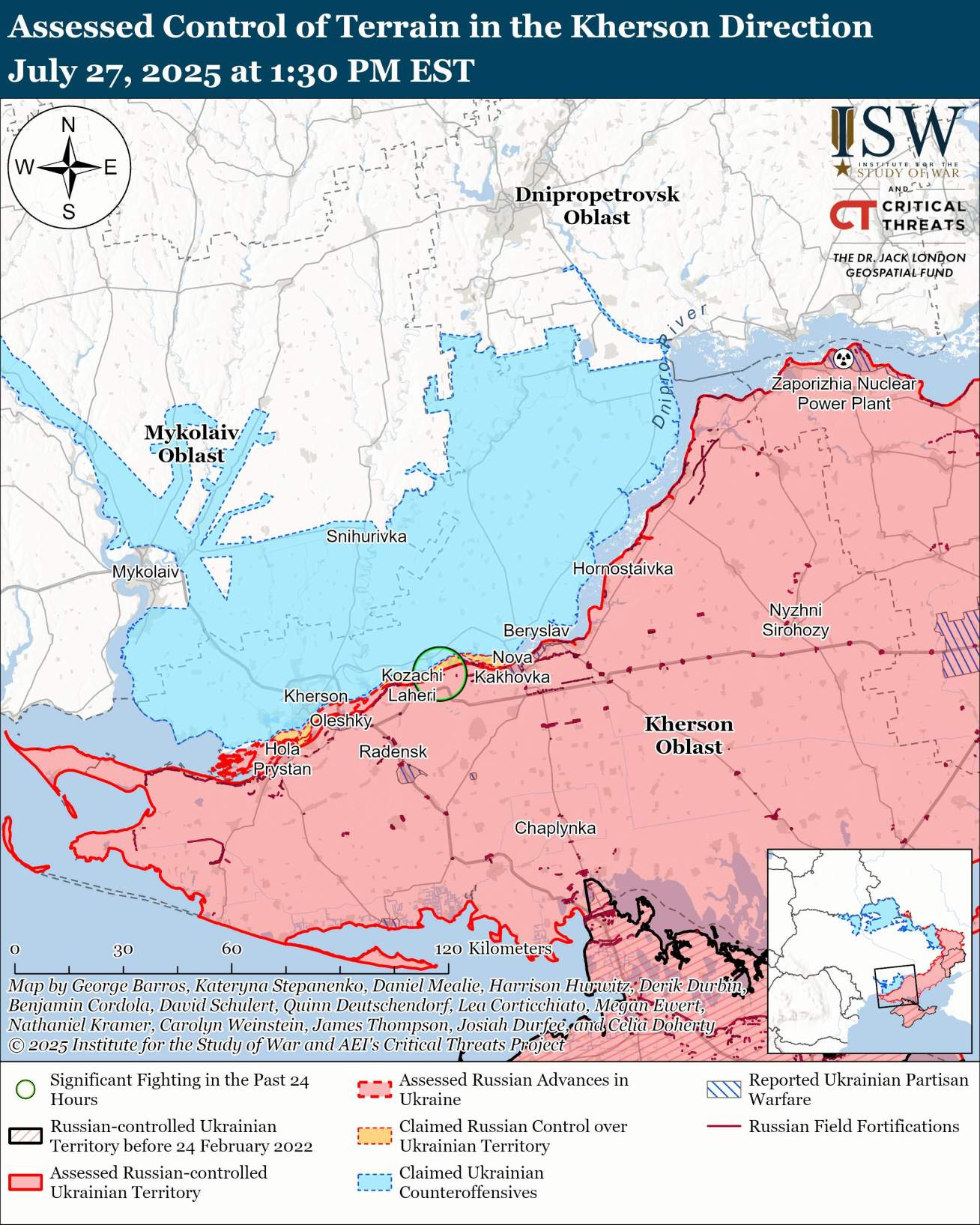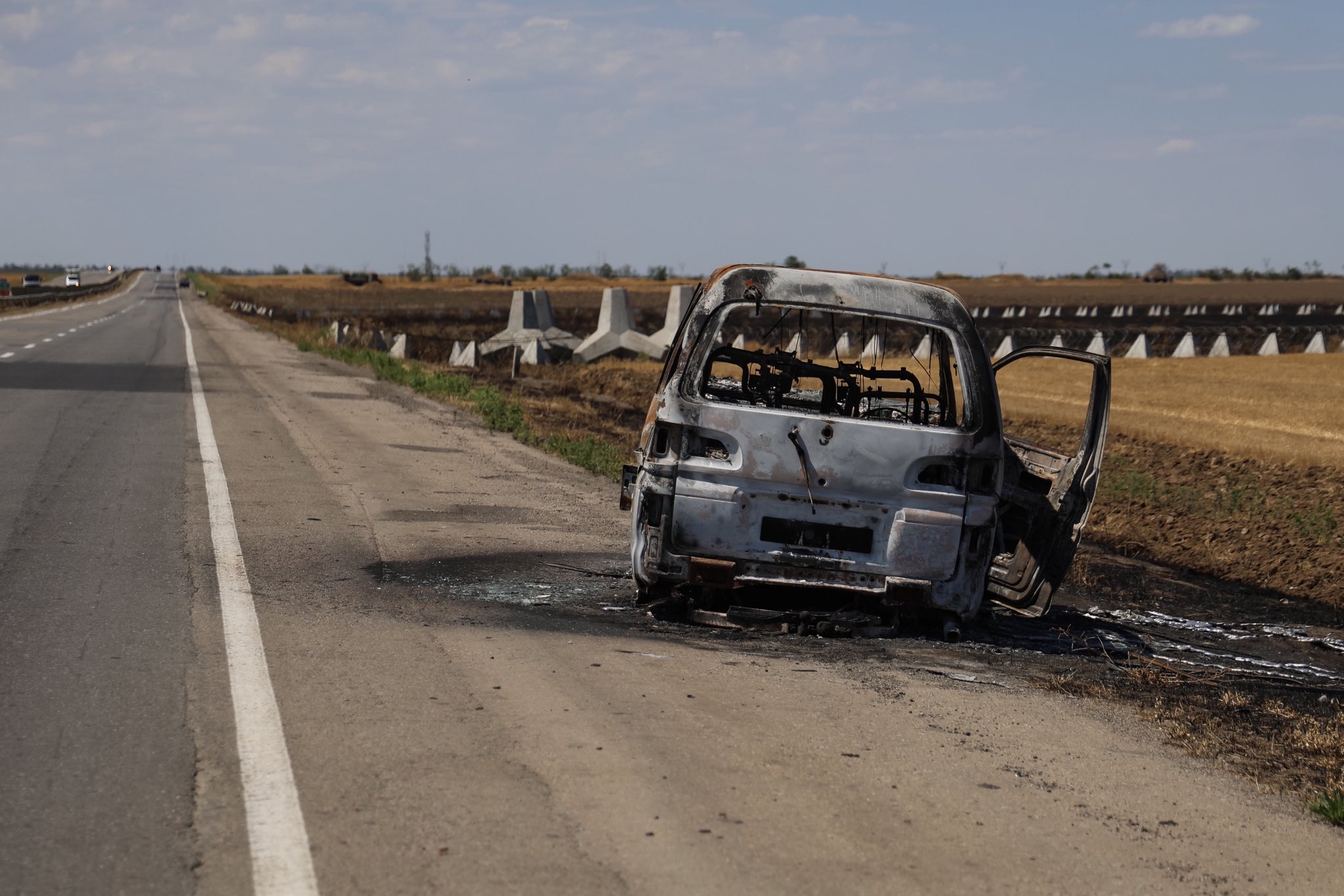Support our mission to provide fearless stories about and outside the media system
Read our
Digital / Print Editions
Packed with exclusive investigations, analysis, and features
A charred car, struck by a Russian FPV drone, caught Ukrainian photojournalist Ivan Antypenko’s eye as he drove along the Kherson–Mykolaiv highway.
“Bad news,” he wrote on social media.
Reporting from the south of Ukraine since the start of the Russian full-scale invasion in 2022, Antypenko has documented dozens of drone-struck vehicles. This one was different: he knew it was a harbinger of a drone siege.
For Kherson, a city of 60,000, separated from the Russian military by less than a mile of the Dnipro River and under non-stop attacks, the highway to Mykolaiv, a major seaport, is a lifeline to Ukrainian-controlled territory. The highway is Kherson’s main artery for evacuation, aid and supply. In July 2025, that lifeline is being severed – from the sky. If this strategy succeeds, Kherson risks becoming the first city besieged by drones.
The city and its main highway are already a “kill zone” – a stretch near the frontline dominated by first-person-view (FPV) drones, remotely operated aircraft used by both sides to strike military and civilian targets with speed and precision. Shutting down Kherson’s main road with FPV drones would allow Russian forces to encircle the city for the second time since the beginning of the full-scale invasion in February 2022 – this time, without setting foot on the ground.
Russian drone attacks along the Kherson–Mykolaiv highway increased to one to two cars per week during July 2025, according to Oleksandr Tolokonnikov, Deputy Head of the Kherson Regional Military Administration.

“There have been at least three recent attacks in Klapaya and near the Chornobaivka checkpoint,” said Tolokonnikov in an interview with Byline Times. “One of the targeted vehicles belonged to the Chief Rabbi of Kherson – he and his family were unharmed.”
Antypenko and other local journalists reported that farmers in the Kherson region could not harvest crops sown last autumn or spring due to attacks by large FPV drones and artillery setting fire to fields and agricultural equipment.
It is possible that the Russian military is shifting tactics because drone defence inside Kherson has improved, according to Tolokonnikov. Parts of the city are now shielded with anti-drone nets. Ukrainian forces use electronic warfare, small arms and target Russian drone crews across the river. As Kherson becomes harder to hit directly, Russian drone pilots are targeting its outskirts and the road to Mykolaiv.
“The Russians know it’s a key route, and that is precisely why they are targeting it,” said Tolokonnikov.
Authorities have urged civilians to avoid the route unless absolutely necessary, and anti-drone nets are now being installed in the Chornobaivka area. Yet, once considered safe, the road is now lethal.
The strategy is clear: isolate, choke supply lines and break resistance without direct engagement. The city is being besieged – by unmanned systems alone. If this tactic succeeds, Kherson faces a humanitarian crisis.
Geography
Kherson sits on the right (western) bank of the Dnipro River. To the east lies the river, now a frontline, and the Russian-occupied left bank, from which artillery and drones strike the city daily. Around Kherson, the fields are mined and side dirt roads are destroyed – not accessible in wet weather and impassable for supply trucks. Russian forces continue remote mining. Large sections of key roads, such as the Mar’yanske–Beryslav road and the route to Snihurivka, are already compromised or under Russian drone control, according to Antypenko.
“The side roads closer to the river are under drone and artillery attack,” said Oleh, a Kherson volunteer. “Security measures implemented by our authorities are not efficient enough. Remote mining is another problem.”
The only open and accessible route to and from Kherson is the highway to Mykolaiv. This single artery brings in food, medicine and humanitarian aid. Artillery cannot reach the Kherson–Mykolaiv highway from across the Dnipro River, but drones can – particularly fibre-optic drones and solar-powered sleeper types.
When Russian forces first captured Kherson in 2022, they did so by crossing the Antonivsʹkyy Bridge and the Kakhovka dam and encircling the city. Both crossings have since been destroyed, and there are no underground passages, despite urban folklore, so the Russians can no longer take the city by land. The Russian military has attempted to recapture Kherson by water but continues to fail to cross the Dnipro or hold its islands, losing hundreds of troops.
The most recent attempt to recapture Kherson is by cutting it off from the rest of the Ukrainian-controlled territories from above, using FPV drones to turn the highway into a “kill zone” – and begin a drone siege.
Since July 2024, Russia has used FPV drones to hunt civilians in Kherson in what is known locally as the “human safari”.
Human Safari
“Human safari” is the term used by locals to describe Russia’s evolving drone warfare tactics targeting civilians in Kherson. FPV drones hunt people in the streets, fields or in their backyards, dropping explosives, incendiary mixtures and banned anti-personnel mines. Byline Times first reported on this war crime in July 2024.
Russian forces systematically target emergency and utility vehicles and civilian infrastructure, including homes, gas pipelines and electrical substations, to create mass displacement. Human Rights Watch and United Nations reports have identified these acts as war crimes and crimes against humanity.
Drone attacks on the right bank of the Kherson region killed 84 people and injured 830 civilians from 1 January to 13 July 2025, according to the city administration.
Footage of these attacks is filmed by Russian drone operators and circulated via a Russian Telegram channel associated with the military, along with daily threats to the local population.
Siege
Merriam-Webster defines a siege as a military blockade of a city or fortified place to compel surrender. From Troy in the Iliad to Constantinople and Leningrad, sieges have shaped warfare. Key elements include encirclement, severed supply lines, isolation and psychological pressure.
“Psychological pressure is palpable. It is a fear campaign,” said Olha, a grocery store owner. “Russian drones are blocking civilian traffic and humanitarian and medical supplies.”
According to her, business and trade in Kherson are down about 30% compared to last year. There is less demand as many people have left and others cannot afford to spend. In summer, Kherson’s residents traditionally use produce from their kitchen gardens.
“It is hard to continue the operation,” she said. “Most truck drivers do not want to deliver goods to Kherson as it is too dangerous. Big supermarkets are closing. Small corner stores do not get deliveries. For instance, eggs are not delivered to downtown and coastal areas. As a result, people – particularly disabled and elderly people – are struggling to get groceries.”
Russian drones have already attacked around five gas stations recently, and only five or six remain operational, making it harder to obtain fuel to reach safer areas. Some pharmacies and postal offices still operate, except those destroyed by shelling and aerial bombs.
Oleh, a volunteer, agrees. “The siege is part of a panic-inciting campaign – along with guided aerial bomb attacks and the human safari.”
A Russian Telegram channel associated with the military openly states the goal of the terror campaigns in Kherson: “Unfortunately, the fate of the city is predetermined… In theory, by mid-2026, the city will be completely destroyed and… the battles will unfold on the ruins.”
During Russia’s full-scale invasion of Ukraine, cities such as Bakhmut and Avdiivka were destroyed through a combination of infantry assaults and tactical drone use to isolate positions. Kherson marks a new phase: strategic isolation by drones alone, without ground troops. It may become the first city in history besieged entirely from the air.

